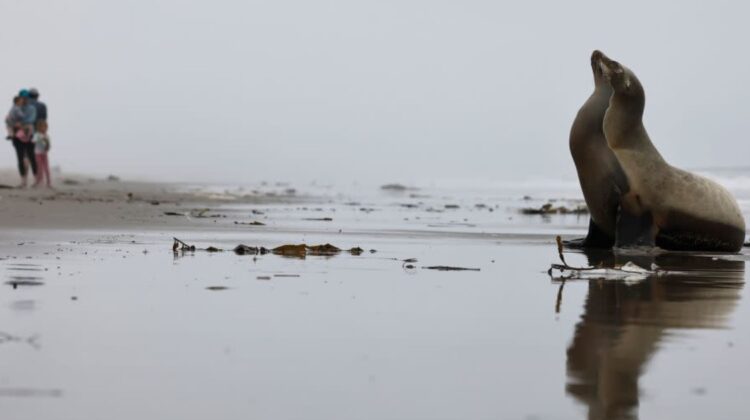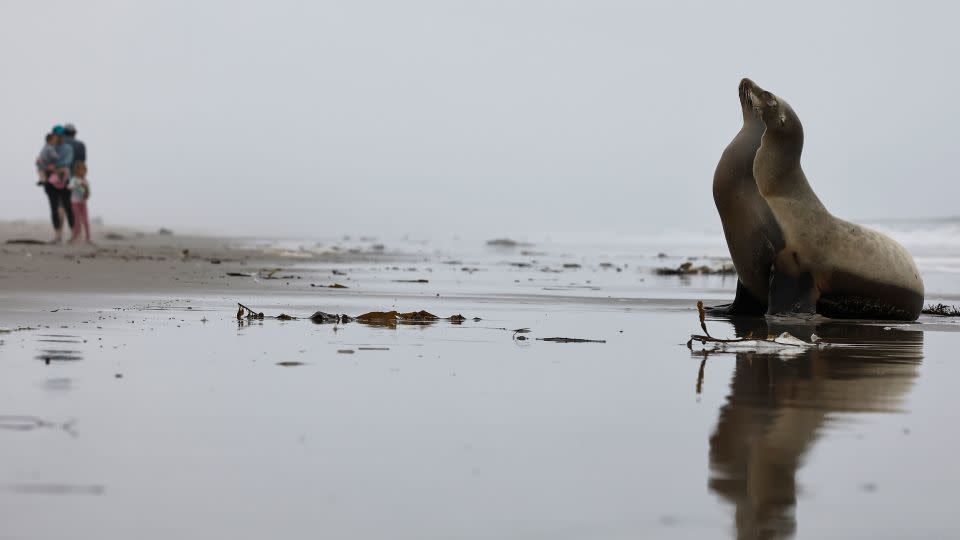
Along some 70 miles of Southern California coastline, the familiar, often playful interactions with sea lions in the water have taken a disturbing turn. Reports are surfacing of these marine mammals, usually a source of delight for swimmers and surfers, exhibiting aggressive behavior and attacking humans. Experts are pointing to a grim reason behind this unsettling change: the very ocean these creatures inhabit is poisoning them, leading to unprecedented levels of sickness and, tragically, death.
The firsthand accounts are alarming. Pheobe Beltran, a 15-year-old aspiring junior lifeguard in Long Beach, experienced a terrifying encounter on March 30th. While finishing her 1,000-yard swim, a sea lion attacked her right arm, leaving her with bites, bruises, and scratches. “I was just so scared, so shocked, but I still felt the immense pain on my arms, like, over and over again,” she recounted to CNN affiliate KCAL.
Just days prior, on March 21st, a surfer near Oxnard, RJ LaMendola, was also targeted by a sea lion in open water. He described the encounter as “harrowing and traumatic,” detailing how the animal “erupted from the water, hurtling toward” him with a “feral, almost demonic” expression, a stark contrast to the playful demeanor he had always associated with sea lions. The encounter left him shaken as the sea lion stalked him back to shore.

The cause behind this aberrant behavior isn’t malice, but a debilitating condition known as domoic acid toxicosis, a consequence of toxic algal blooms, often referred to as red tide. John Warner, CEO of the Marine Mammal Care Center in Los Angeles, paints a grim picture. “The sea lions are coming in almost comatose by the time they’re stranding. Something is happening in this particular bloom that seems worse on multiple levels,” he explains, adding that the sheer volume of sick animals is “definitely the worst we’ve ever seen.”
Dolphins are also falling victim to this environmental crisis. When the neurological toxin infiltrates the sea lions’ food supply, it triggers breathing difficulties and seizures, including a distinctive “stargazing” seizure where the animals unnaturally extend their heads backward with closed eyes. “When they are affected with this toxin, they’re out of their minds,” Warner emphasizes. “They’re scared. They’re totally disoriented and frightened. They really don’t understand where they are. They’re struggling to even get out of the water, so they don’t drown.”

This state of distress can lead to a “hyper-energetic fight or flight kind of aggressive or scared behavior,” according to Warner. He cautions that if humans inadvertently approach these disoriented animals, negative interactions, including attacks, can occur.
The Marine Mammal Care Center is grappling with an overwhelming surge of sick and stranded animals. Typically receiving 3,000 to 4,000 calls annually in normal circumstances, they have already fielded over 2,000 calls in the past five weeks alone – a “tsunami” of need, as Warner describes it.
The root of the problem lies in the natural presence of domoic acid in the Pacific Ocean. However, a process called upwelling is exacerbating the issue, pushing the acid into the aquatic food chain. As winds churn up cold, nutrient-rich sediment from the ocean floor, it fuels the growth of toxic algae. This abundant toxic algae then enters the food chain, impacting smaller creatures that are subsequently consumed by larger animals like pelicans, whales, and various fish.

Compounding this natural process are the detrimental effects of human-induced climate change and land development. Warmer, more acidic ocean surface temperatures favor algal growth, while nitrogen fertilizer runoff from farming provides an excess of nutrients, further fueling these harmful blooms. Alarmingly, these blooms, which once occurred sporadically, are now becoming an annual event, according to Warner.
The consequences are dire. In 2023, the Marine Mammal Care Center reported the worst algae event in recorded history in Southern California. This year is already witnessing an increase not only in the number of sick animals but also in the severity of their illness when they are found stranded. While approximately 50% to 65% of affected sea lions typically recover, Warner notes that the higher toxicity levels this year are making recovery more challenging. Many animals remain in a comatose state for weeks, casting doubt on their chances of survival. This could lead to a significantly lower survival rate compared to previous blooms.

The crisis is particularly impacting pregnant sea lions, which make up an estimated 80% of the center’s current patients. The toxic domoic acid often forces mothers to expel their fetuses to survive. While the overall sea lion population remains robust for now, Warner warns that this trend could have long-term implications for the species, with increasing numbers of elephant seal and sea lion pups also stranding.
The dedicated team at the Marine Mammal Care Center is working tirelessly to rehabilitate the affected animals. Their efforts focus on flushing the water-soluble toxin from the sea lions’ systems through the administration of fluids and nutrition. Anti-seizure medications are also crucial in preventing permanent brain damage. Initially, the sea lions are tube-fed twice daily, and while they typically resume self-feeding within a week, recovery is taking longer this year. The goal is to return the animals to the ocean as quickly as possible, not only for their well-being but also to create space for the continuous influx of sick animals. The center has even opened a triage site in its parking lot to accommodate an additional 25 animals.

Tragically, domoic toxin poisoning is often a death sentence for dolphins. This year has been the worst the center has witnessed for these marine mammals, with over 70 strandings in Los Angeles County alone. Unlike sea lions, there is no effective rehabilitation for affected dolphins. “Most of the time when they strand, they’re already deceased. The ones that are struggling on the beaches that are seizing,” Warner explains with sorrow. “The best thing we can do is humanely euthanize them which, unfortunately, we’ve had to do more than we’ve ever done before.” Only about 20 of the stranded dolphins encountered this year have been alive.
The sheer scale of this crisis is straining the resources of the Marine Mammal Care Center. As of the end of March, they have treated 240 animals, nearing their annual budget of 300, which covers essential costs like medicine, food, personnel, freezer storage, and animal disposal.

The location of the recent sea lion attacks, near the Channel Islands – the primary breeding ground for California sea lions, where 85% are born in June – is significant. Warner notes that this area “seems to be the epicenter of these domoic acid events the last four years.”
The unusual aggression in California’s sea lions is a stark reminder of the delicate balance of our ecosystems and the far-reaching consequences of environmental changes. As the ocean they depend on turns against them, these once playful creatures are exhibiting desperate and dangerous behavior. Understanding the “why” behind these attacks – the toxic algal blooms fueled by natural processes and exacerbated by human activities – is crucial in addressing this crisis and working towards a healthier future for both marine life and the humans who share their coastal home.

Leave a Reply